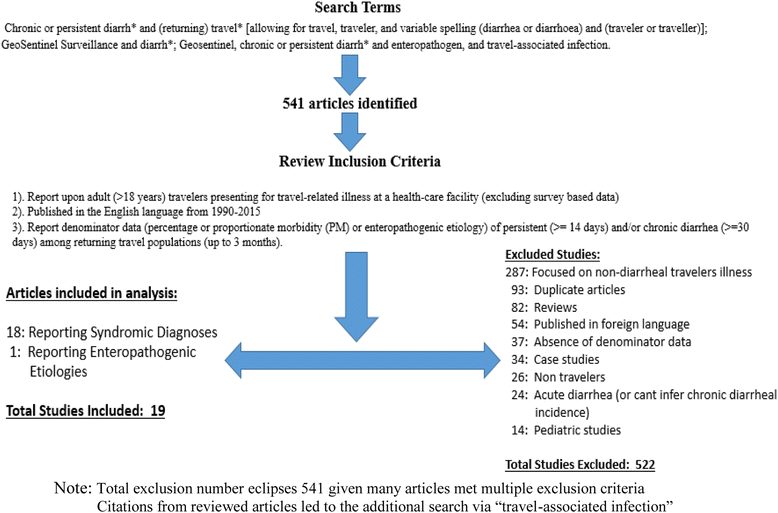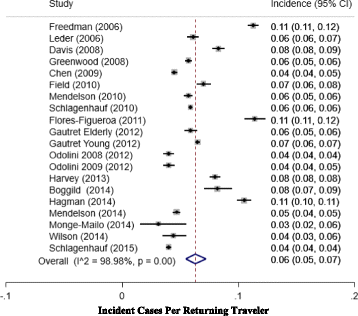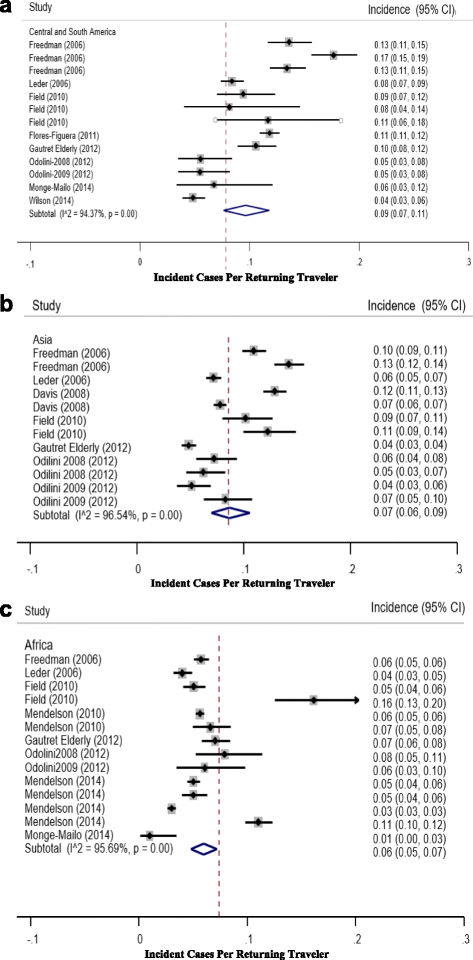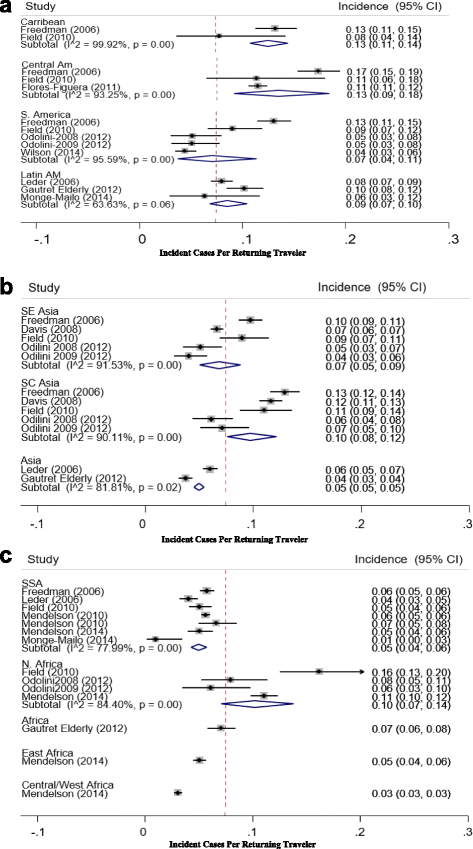Review: chronic and persistent diarrhea with a focus in the returning traveler
- PMID: 28883979
- PMCID: PMC5531020
- DOI: 10.1186/s40794-017-0052-2
Review: chronic and persistent diarrhea with a focus in the returning traveler
Abstract
Background: Travelers' diarrhea is a common malady afflicting up to 50% of travelers after a 2-week travel period. An appreciable percentage of these cases will become persistent or chronic. We summarized the published literature reporting persistent/chronic diarrhea in travelers elucidating current understanding of disease incidence, etiology and regional variability.
Methods: We searched electronic databases (Medline, Embase, and Cochrane database of clinical trials) from 1990 to 2015 using the following terms: "chronic or persistent diarrh* and (returning) travel* or enteropathogen, GeoSentinel, and travel-associated infection. Included studies published in the English language on adult returning travelers (duration < 3-months) reporting denominator data. Point estimates and standard 95% confidence intervals were calculated for incidence using a random-effects model. Study incidence heterogeneity rates were assessed using x2 heterogeneity statistics, graphically represented with Forest plots.
Results: We identified 19 studies meeting the inclusion criteria (all published after 1999). 18 studies reported upon the incidence of persistent/chronic diarrhea as a syndromic diagnosis in returning travelers; one study reported adequate denominator data from which to assess pathogen specific etiology. Giardiasis comprise an appreicaible percentage of infectious mediated persistent/chronic diarrhea in returning travelers. The overall estimate of persistent/chronic diarrhea incidence was 6% (0.05-0.07) in 321,454, travelers; with significant heterogeniety observed across regions. The total number of regional travelers, and point estimates for incidence (95% CI) for Latin American, African, and Asian travelers were [15816 (0.09 [0.07-0.11]), 42290 (0.06 [0.05-0.07]), and 27433 (0.07 [0.06-0.09])] respectively. We identified lower published rates of chronic diarrhea from Sub-Saharan Africa relative to [North Africa, South Central Asia, and Central America]. Persistent/chronic diarrhea ranked fourth as a syndromic diagnosis in all regions.
Conclusions: Persistent/Chronic diarrhea is a leading syndromic diagnosis in returning travelers across all regions. The 6% incidence [proportionate morbidity (PM) of 60] observed in over >300,000 global travelers is comparable to prior estimates. We identified lower published rates of chronic diarrhea from Sub-Saharan Africa relative to [North Africa, South Central Asia, and Central America]. Giardiasis comprises an appreciabile percentatge of travel-associated infectious mediated persistent/chronic diarrhea. There's a dearth of published data characterizing the incidence of specific enteropathogenic etiologies for persistent/chronic diarrhea in returning travelers.
Keywords: Chronic diarrhea; Enteropathogens; GeoSentinel surveillance; Giardiasis; Persistent diarrhea; Post-infectious irritable bowel syndrome; Travelers’ diarrhea.
Figures




Similar articles
-
Surveillance for travel-related disease--GeoSentinel Surveillance System, United States, 1997-2011.MMWR Surveill Summ. 2013 Jul 19;62:1-23. MMWR Surveill Summ. 2013. PMID: 23863769
-
Spectrum of disease and relation to place of exposure among ill returned travelers.N Engl J Med. 2006 Jan 12;354(2):119-30. doi: 10.1056/NEJMoa051331. N Engl J Med. 2006. PMID: 16407507
-
Travelers' diarrhea.Curr Opin Infect Dis. 2010 Oct;23(5):481-7. doi: 10.1097/QCO.0b013e32833dfca5. Curr Opin Infect Dis. 2010. PMID: 20683261 Review.
-
Travelers' diarrhea: update on the incidence, etiology and risk in military and similar populations - 1990-2005 versus 2005-2015, does a decade make a difference?Trop Dis Travel Med Vaccines. 2019 Jan 15;5:1. doi: 10.1186/s40794-018-0077-1. eCollection 2019. Trop Dis Travel Med Vaccines. 2019. PMID: 30675367 Free PMC article.
-
Incidence, etiology, and impact of diarrhea among long-term travelers (US military and similar populations): a systematic review.Am J Trop Med Hyg. 2006 May;74(5):891-900. Am J Trop Med Hyg. 2006. PMID: 16687698
Cited by
-
Antimicrobial Resistance in the Asia Pacific region: a meeting report.Antimicrob Resist Infect Control. 2019 Dec 18;8:202. doi: 10.1186/s13756-019-0654-8. eCollection 2019. Antimicrob Resist Infect Control. 2019. PMID: 31890158 Free PMC article.
-
Is the Medium Still the Message? Culture-Independent Diagnosis of Gastrointestinal Infections.Dig Dis Sci. 2022 Jan;67(1):16-25. doi: 10.1007/s10620-021-07330-6. Epub 2021 Nov 30. Dig Dis Sci. 2022. PMID: 34846676 Review.
-
Travel-related gastrointestinal diseases: Assessment and management.Public Health Chall. 2022 Nov 2;1(4):e30. doi: 10.1002/puh2.30. eCollection 2022 Dec. Public Health Chall. 2022. PMID: 40496677 Free PMC article. Review.
-
Expanding the antiprotozoal activity and the mechanism of action of n-butyl and iso-butyl ester of quinoxaline-1,4-di-N-oxide derivatives against Giardia lamblia, Trichomonas vaginalis, and Entamoeba histolytica. An in vitro and in silico approach.J Enzyme Inhib Med Chem. 2024 Dec;39(1):2413018. doi: 10.1080/14756366.2024.2413018. Epub 2024 Oct 29. J Enzyme Inhib Med Chem. 2024. PMID: 39470324 Free PMC article.
-
Fever in the Returned Pediatric Traveler.Glob Pediatr Health. 2021 Aug 16;8:2333794X211026188. doi: 10.1177/2333794X211026188. eCollection 2021. Glob Pediatr Health. 2021. PMID: 34423077 Free PMC article. Review.
References
-
- Harvey K, Esposito DH, Han P, Kozarsky P, Freedman DO, Plier DA, Sotir MJ, Centers for Disease Control and Prevention (CDC) Surveillance for travel-related disease--GeoSentinel Surveillance System, United States, 1997–2011. MMWR Surveill Summ. 2013;62:1–23. - PubMed
-
- Flores-Figueroa J, Okhuysen PC, von Sonnenburg F, DuPont HL, Libman MD, Keystone JS, Hale DC, Burchard G, Han PV, Wilder-Smith A, Freedman DO, GeoSentinel Surveillance Network Patterns of illness in travelers visiting Mexico and Central America: the GeoSentinel experience. Clin Infect Dis. 2011;53(6):523–31. doi: 10.1093/cid/cir468. - DOI - PubMed
Publication types
LinkOut - more resources
Full Text Sources
Other Literature Sources

